Chicago campus
History
| | This section is empty. You can help by adding to it. (February 2013) |
The campus of Northwestern University encompasses two campuses in Evanston, Illinois and Chicago, Illinois, United States. There is an additional campus located in Doha, Qatar which offers bachelor's and master's degrees. The original Evanston campus has witnessed approximately 150 buildings rise on its 240 acres (0.97 km2) since the first building opened in 1855. The downtown Chicago campus of approximately 25 acres (100,000 m2) is home to the schools of medicine and law was purchased and constructed in the 1920s and 1930s.
In the 1960s, the University added 84 acres (340,000 m2) to the campus by building a seawall and filling in the interior with sand. Only a portion of the landfill has been used for new buildings, and a portion on the east side of a lagoon is still undeveloped. [1]
The Charles Deering Library is a library located on the main Evanston campus of Northwestern University. The Deering Library presently houses the Government Publications Department and the Northwestern University Archives on the first floor, the Music Library on the second floor, and the Map Collection, the Art Reference Collection and the Special Collections Department on the third floor. The Deering Library served as Northwestern's main library until the completion of the University Library in 1970. [2]
The Northwestern University Library is the principal library for the Evanston campus of Northwestern University. The library holds 4.6 million volumes, making it the 11th largest library at a private university. [3] The building was designed in brutalist style by Walter Netsch of Skidmore, Owings and Merrill. Construction started in 1966 and the library opened in 1970. The library succeeded the Charles Deering Library as the main library on campus. The Deering Library was connected to the main library through construction, and continues to house the University's special collections. [4]
The Dearborn Observatory is an observatory, located on the Evanston campus of Northwestern University. The observatory was originally constructed in 1888. In the summer of 1939, Dearborn Observatory was moved to make way for the construction of the Technological Institute. [5]
University Hall is the oldest original building on the Northwestern University campus. University Hall was actually the second building constructed on the Northwestern University campus. The building known as "Old College" was constructed as a temporary building in 1855, though it stood on campus until the 1970s. University Hall was designed in Victorian Gothic style by G. P. Randall, and is composed of Joliet limestone - the same kind used to build the Chicago Water Tower. [6] The construction materials were transported to the Evanston campus by lake boat and rail.
The cornerstone of the building was laid in 1868, and the structure was completed in 1869, at a total cost of $125,000. University Hall officially opened on September 8, 1869 and coincided with the inauguration of University President Erastus Otis Haven. Speakers at the opening ceremony included Illinois Governor John M. Palmer, and the new University President Haven, who called the structure, "the new and elegant University Building". [7] The clock in the tower of University Hall was the gift of the Class of 1879; its movement was built by clockmaker Seth Thomas. In 1966, a new electrified clock replaced the old works, which are now located in the Smithsonian National Museum of American History. [8]
University Hall took over most university functions from Old College and contained classrooms housing all University classes, the library, a chemical lab, a chapel, two society rooms and a fourth-floor natural history museum. University Hall contained Northwestern's primary library until the construction of Lunt Library in the 1890s. Though it was succeeded by Fayerweather Hall as the university's main building in 1887, University Hall served a variety of functions. Over the years University Hall has been the home of the central administration, the engineering school, a cafeteria, and faculty offices. [9] University Hall underwent a $5.2 million renovation and was rededicated in 1993. [8] The building is currently home to Northwestern's English department.
The Technological Institute , more commonly known as "Tech", is a landmark building at Northwestern University. Robert R. McCormick School of Engineering and Applied Science following a major gift from the Robert R. McCormick Foundation. It is the main building for students and faculty in the Robert R. McCormick School of Engineering and Applied Science. The construction of the building started in 1939 when Walter P. Murphy, a wealthy inventor of railroad equipment, donated $6.737 million. Murphy meant for the Institute to offer a new kind of "cooperative" educational model for the field, where academic courses and practical application in industrial settings were closely integrated. When the construction of Tech was completed in 1942, Northwestern received an additional bequest of $28 million from Walter P. Murphy's estate to provide for an engineering school "second to none."
To make room for the new building, the Phi Kappa Psi fraternity house and the Dearborn Observatory were moved, and the original Patten Gymnasium was demolished. Ground was broken for the new building on April 1, 1940, and the building was dedicated on June 15–16, 1942. The building was designed by the architectural firm of Holabird & Root in the shape of two letter E's, placed back to back and joined by a central structure. When it was built it was the largest building on Northwestern's Evanston campus.
In 1961, construction began on two new wings, which were added to the eastern ends of the building, along with additions to the library and physics wing. The expansion, dedicated in October 1963, was prompted by a $3.4 million contract awarded by the Advanced Research Agency of the Department of Defense. In 1973, a new entrance terrace was dedicated, and in 1999, a ten-year, $125 million renovation of the Technological institute was completed. This renovation, undertaken by Skidmore, Owings & Merrill, included extensive reconstruction of the interior of the original 1940 structure, replacing the mechanical, plumbing, and electrical systems, and reconfiguring the laboratory and research space. [10]
Additional buildings have been constructed around the original Technological Institute, connected together by pedestrian bridges to create what has been called the "Technological Campus". Among them are the Seeley G. Mudd Library for Science and Engineering opened in 1977, the Center for Catalysis and Surface Science in 1986, and Cook Hall in 1989. More recent additions to the "Technological Campus" include Hogan Hall, the Pancoe Life Sciences Pavilion, the Center for Nanofabrication, and the Ford Motor Company Engineering Design Center.
| | This section is empty. You can help by adding to it. (February 2013) |
| | This section is empty. You can help by adding to it. (July 2010) |
| | This section is empty. You can help by adding to it. (July 2010) |
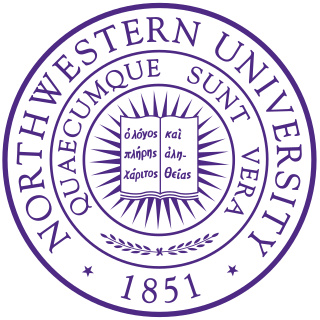
Northwestern University (NU) is a private research university in Evanston, Illinois. Established in 1851 to serve the historic Northwest Territory, it is the oldest chartered university in Illinois. The university has its main campus along the shores of Lake Michigan in the Chicago metropolitan area.

Cork Institute of Technology was an institute of technology, located in Cork, Ireland. Upon its dissolution, the institute had 17,000 students studying in art, business, engineering, music, drama and science disciplines. The institute had been named as Institute of Technology of the Year in The Sunday Times University Guide for Ireland on numerous occasions. On 1 January 2021, the institute merged with the Institute of Technology, Tralee to become the Munster Technological University, Ireland's second technological university.

Pratt Institute is a private university with its main campus in Brooklyn, New York. It has a satellite campus in Manhattan and an extension campus in Utica, New York at the Munson-Williams-Proctor Arts Institute. The school was founded in 1887 with programs primarily in engineering, architecture, and fine arts. Comprising six schools, the institute is primarily known for its programs in architecture, graphic design, interior design, and industrial design.

The Harvard University Science Center is Harvard University's main classroom and laboratory building for undergraduate science and mathematics, in addition to housing numerous other facilities and services. Located just north of Harvard Yard, the Science Center was built in 1972 and opened in 1973 after a design by Josep Lluís Sert, who was then dean of the Harvard Graduate School of Design.

The McCormick School of Engineering is the engineering school of Northwestern University, a private university in Evanston, Illinois.

The Technological Institute, more commonly known as "Tech", is a landmark building at Northwestern University built from 1940 to 1942. It is the main building for students and faculty in the Robert R. McCormick School of Engineering and Applied Science. The school of engineering itself was called the Technological Institute before a major gift from the Robert R. McCormick Foundation gave it the present name.
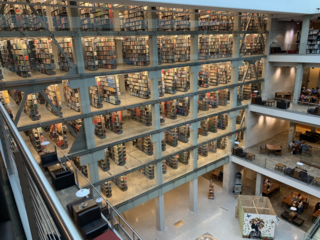
The William Oxley Thompson Memorial Library is the main library at Ohio State University's Columbus campus. It is the university's largest library and houses its main stacks, special collections, rare books and manuscripts, and many departmental subject libraries. The library was originally built in 1912, and was renovated in 1951, 1977, and 2009. It is named in honor of the university's fifth president, William Oxley Thompson.
The history of Northwestern University can be traced back to a May 31, 1850, meeting of nine prominent Chicago businessmen who shared a desire to establish a university to serve the former Northwest Territory. On January 28, 1851, the Illinois General Assembly granted a charter to the Trustees of the North-Western University making it the first recognized university in Illinois.[a] While the original founders were devout Methodists and affiliated the university with Methodist Episcopal Church, they were committed to non-sectarian admissions.

Charles Deering Library is an academic library of Northwestern University, a private research university in Evanston, Illinois. Deering served as the university's main library on the Evanston campus from 1933, when it was established, until the construction of the Northwestern University Main Library in 1970.

Northwestern University Libraries is the main academic library system of Northwestern University. Northwestern Libraries host a total of 8,198,268 printed or electronic volumes. In addition, its libraries contain 229,198 maps, 211,127 audio files, 103,377 printed journals, 196,716 electronic journals, 91,334 movies or videos, 36,989 manuscripts, 4.6 million microforms, and almost 99,000 periodicals. The University Library is the 14th-largest university library in North America based on total number of titles held.

The Dearborn Observatory is an astronomical observatory located on the Evanston campus of Northwestern University. The observatory was originally constructed in 1888, through an agreement between the university and the Chicago Astronomical Society. In the summer of 1939, Dearborn Observatory had to be moved to make way for the construction of the Technological Institute.

University Hall is the oldest original building on the Northwestern University campus in Evanston, Illinois, and the second building to have been constructed after Old College, which stood on campus until the 1970s. The building has served a wide range of different roles since its construction, and currently houses the university's English department.
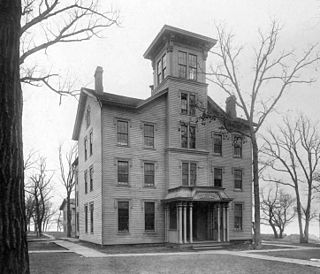
Old College was the first building constructed at Northwestern University in Evanston, Illinois, and was completed in 1855. Although intended to be temporary, it served in various capacities including classrooms, a library, and offices until it was razed after being extensively damaged in 1973.
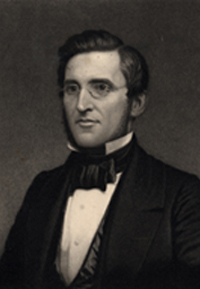
Joseph Cummings was an American academic who served as the 5th president of Wesleyan University from 1857 to 1875, the 5th president of Northwestern University from 1881 to 1890, and the president of Genesee College from 1854 to 1857.
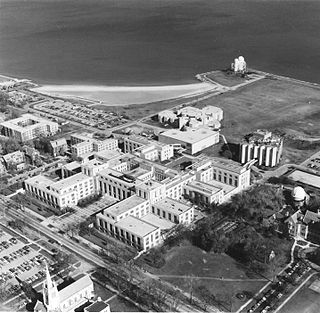
The Northwestern University Lakefill is a large area of Northwestern University land that was reclaimed from Lake Michigan in 1962–1964 by creating a seawall of limestone blocks quarried in Illinois and Indiana and using landfill materials from the construction of the Port of Indiana. The lakefill resulted from the university's need to expand the campus's physical footprint; Northwestern President J. Roscoe Miller received permission from the town of Evanston and the Illinois legislature to reclaim 74 acres of underwater land. This almost doubled the size of the previously 85 acres campus. In 1968, the lakefill was expanded by an additional 10 acres on the southern end of the campus.

Michigan Technological University's campus sits on 925 acres on a bluff overlooking Portage Lake.

Lindheimer Astrophysical Research Center was an astronomical observatory used for teaching and research, located on the Evanston, Illinois campus of Northwestern University. The structure was built in 1966 and was demolished in 1995.